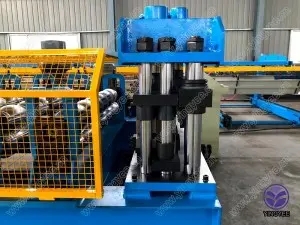
Stud and Track Keel Roll Forming An Overview
In the modern manufacturing landscape, efficient processes and precision engineering are paramount. Among the various techniques utilized to fabricate metal components, roll forming stands out, especially when combined with the production of stud and track systems. Stud and track keel roll forming integrates the principles of roll forming with the specific needs of constructing frameworks, particularly in the creation of structures like walls, roofs, and ceilings.
Understanding Roll Forming
Roll forming is a continuous bending process in which a long strip of metal is passed through successive pairs of rolls. As the metal moves through the rolls, it is gradually shaped into a desired profile. This technique is particularly favored for producing parts with uniform cross-section, ensuring consistency and minimizing material wastage. One of the hallmark features of this process is its ability to create complex shapes with tight tolerances.
What are Studs and Tracks?
Studs and tracks are essential components in light gauge metal framing systems, commonly used in the construction industry. The stud acts as a vertical support element, while the track serves as the horizontal support that holds the studs in place. Together, they form a skeletal structure that can support various wall systems, including drywall assemblies.
The use of lightweight metal studs, as opposed to traditional wooden beams, offers numerous advantages. These include increased durability, resistance to pests, and fire safety. Moreover, metal framing systems can be quicker to install, as they are often designed for efficiency and ease of assembly.
The Importance of Keel Roll Forming
Keel roll forming refers to a specific type of roll forming used to produce the unique profiles of studs and tracks. The term keel typically describes a design characterized by a central web and flanges extending outward. This design is vital for ensuring structural integrity, as it distributes loads effectively across the framework.

Keel roll forming machines are engineered to produce precise, high-quality profiles that can be customized to meet exact specifications. This customizability allows manufacturers to cater to diverse projects, adapting dimensions and performance characteristics based on requirements. Businesses engaging in stud and track keel roll forming benefit from reduced production times and the ability to scale operations without compromising quality.
Applications in Construction
The applications of stud and track keel roll forming are widespread within the construction industry. They are found in residential and commercial projects alike, from new builds to refurbishment and renovation works. The popularity of steel framing in contemporary architecture is attributed to its strength-to-weight ratio, ease of installation, and longevity.
Moreover, the trend towards modular and prefabricated construction further amplifies the relevance of keel roll forming. Components manufactured off-site can be readily assembled on-location, leading to faster project completion times and reduced labor costs. This efficiency is particularly desirable in an industry often challenged by time constraints and budget considerations.
Technological Advancements
The field of keel roll forming has evolved in recent years, driven by technological advancements. Automation and computer numerical control (CNC) technologies have transformed the way roll forming processes are executed. Modern roll forming systems may incorporate integrated quality control measures, ensuring that every product meets compliance standards and specifications.
Additionally, advancements in material science have led to the development of higher strength steel grades that can be rolled into even thinner sheets, without sacrificing performance. This evolution allows architects and engineers greater flexibility in their designs, making it possible to produce innovative building frameworks that were not feasible with traditional materials.
Conclusion
Stud and track keel roll forming represents a crucial intersection of advanced manufacturing techniques and the construction industry’s evolving needs. With its focus on efficiency, precision, and adaptability, this method stands out as a vital contributor to modern building practices. As the demand for sustainable and effective construction solutions continues to grow, the role of specialized roll forming techniques like stud and track keel will undoubtedly become more prominent, paving the way for the future of construction. Through continuous innovation and investment in technology, the industry is poised to meet the challenges of tomorrow while fostering an environment of quality and efficiency.